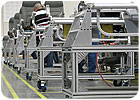When industrial engineer Ryan Newham arrived at the C&D Zodiac assembly plant in Ontario, CA, he knew his work would be cut out for him.

Custom-built racks present components for airplane seats within easy reach of the operator. Enough parts are kept in the racks to assemble five seats. Photo courtesy C&D Zodiac
The plant, which makes seats for passenger jets, was “a complete mess,” Newham recalls. “There were benches everywhere, and people were building seats in large batches. There were about 200 seats on the floor, half-assembled, and people were just going from seat to seat installing parts.”
The plant had to get lean. Newham wanted an assembly line with single-piece flow, and a takt time in sync with customer demand. He wanted parts and subassemblies delivered to the line when and where they were needed through a kanban system. He wanted to improve ergonomics and eliminate wasted motion. And, he wanted to accomplish it all as quickly as possible. Modular structural framing components from Bosch Rexroth Corp. (Buchanan, MI) helped get the job done.
The first step in the process of building the new line was to study the sequence of steps for assembling an airplane seat. “We timed all the operations, then we calculated our takt time according to customer demand,” Newham explains. “Then, we determined how many assembly stations we needed, divided the work, and balanced the line.”
Seats move from station to station on wheeled carts that were custom-built from extruded aluminum profiles and other components. A fixture on top of the cart holds the seat in place while it’s assembled. New workbenches and parts supply racks were also created.
Newham liked the Bosch system because of its flexibility, finish and wide range of components. “We looked at tubular components, but we liked the Bosch hardware because it fit better with what we were trying to do, and it gave us more possibilities,” he says. “One nice thing about the Bosch system is that it’s so adjustable. If you have to move things around, you can.”
Newham is particularly pleased with the first station on the line, where the initial parts of the seat frame are assembled. “All the tools are presented with their handles out, so they’re ready to be grabbed and used,” he says. “I experimented with shadow boards and hooks, but they were just a little too fidgety for the operators. It was too much work to put the tools back in the correct spots. The operators would just drop the tools back on the bench. The way I look at it, if they’re putting the tools on the bench instead of the tool holders I designed, then I designed the tool holders incorrectly.”
Custom-built racks present components of the seat frame within easy reach of the operator. Enough parts are kept in the racks to assemble five seats. “We arbitrarily chose a buffer of five seats, so we could reduce that in the future,” says Newham. “But for now, it’s good.”
After the frame is assembled, the cart is wheeled to the next station, where the bottom of the seat is installed. Subsequent stations add the arms, cabling, reclining mechanisms, trays, cushions, upholstery and other parts. A seat is fully assembled and boxed for shipping every 18 minutes.
At the end of the line, the seats are staged for shipping. “Eventually, we will be able to transfer seats from the end of the line straight onto a waiting truck,” says Newham. “We won’t need any space on the shop floor for finished seats.”
For more information on modular structural framing components, call Bosch at 800-739-7684 or visithttp://www.boschrexroth-us.com.